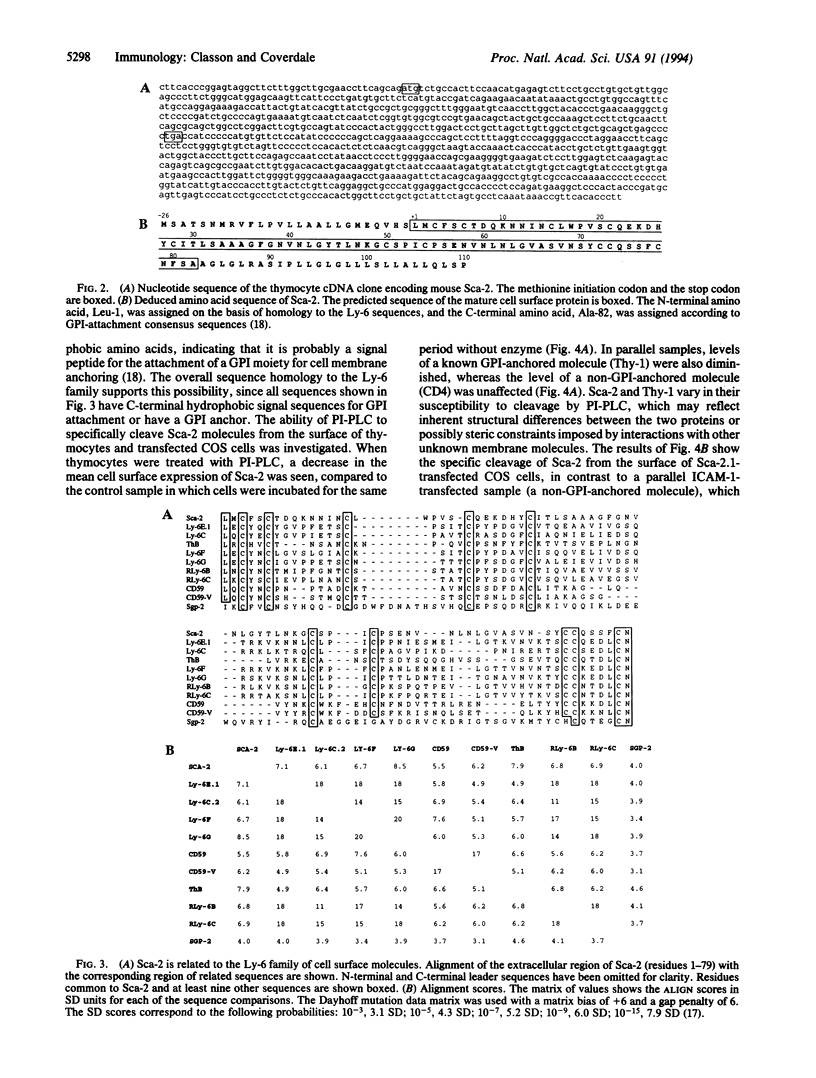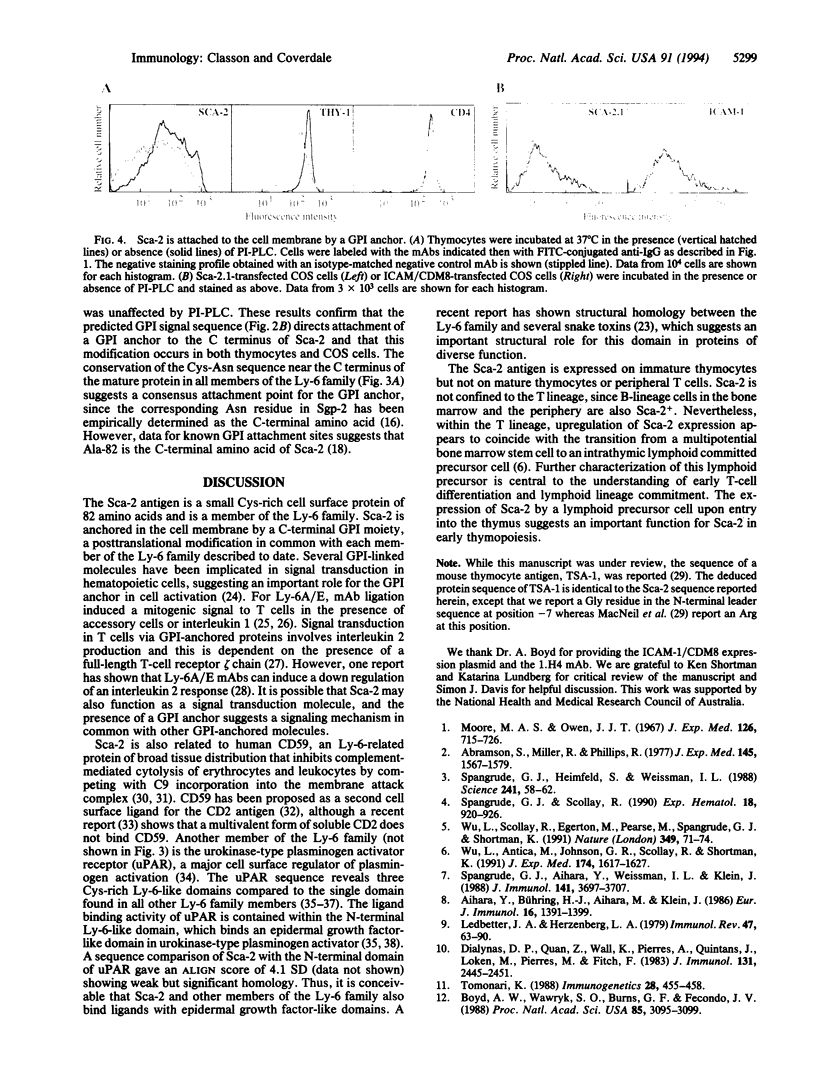Abstract
Mature T lymphocytes arise from intrathymic T-cell precursors, which in turn are derived from a multipotent stem cell in the bone marrow. Unlike bone marrow stem cells, the differentiation potential of the earliest intrathymic precursor cells is strongly biased toward the lymphoid lineage. The major difference in cell surface phenotype between early thymic precursor cells and bone marrow stem cells is that the former population expresses Sca-2. The progeny of the intrathymic precursor population continue to express Sca-2 until the transition from blast cells to small cells, at which stage expression of Sca-2 is down regulated. Mature thymocytes and peripheral T cells do not express detectable levels of Sca-2, whereas peripheral B cells are Sca-2-positive. We report herein the complete sequence of mouse Sca-2 deduced from a thymocyte cDNA clone. Sca-2 is a member of the Ly-6 family, a group of small cysteine-rich cell surface proteins that are anchored in the membrane by a glycosyl-phosphatidylinositol moiety.
Full text
PDF




Images in this article
Selected References
These references are in PubMed. This may not be the complete list of references from this article.
- Abramson S., Miller R. G., Phillips R. A. The identification in adult bone marrow of pluripotent and restricted stem cells of the myeloid and lymphoid systems. J Exp Med. 1977 Jun 1;145(6):1567–1579. doi: 10.1084/jem.145.6.1567. [DOI] [PMC free article] [PubMed] [Google Scholar]
- Aihara Y., Bühring H. J., Aihara M., Klein J. An attempt to produce "pre-T" cell hybridomas and to identify their antigens. Eur J Immunol. 1986 Nov;16(11):1391–1399. doi: 10.1002/eji.1830161113. [DOI] [PubMed] [Google Scholar]
- Appella E., Robinson E. A., Ullrich S. J., Stoppelli M. P., Corti A., Cassani G., Blasi F. The receptor-binding sequence of urokinase. A biological function for the growth-factor module of proteases. J Biol Chem. 1987 Apr 5;262(10):4437–4440. [PubMed] [Google Scholar]
- Aruffo A., Seed B. Molecular cloning of a CD28 cDNA by a high-efficiency COS cell expression system. Proc Natl Acad Sci U S A. 1987 Dec;84(23):8573–8577. doi: 10.1073/pnas.84.23.8573. [DOI] [PMC free article] [PubMed] [Google Scholar]
- Arulanandam A. R., Moingeon P., Concino M. F., Recny M. A., Kato K., Yagita H., Koyasu S., Reinherz E. L. A soluble multimeric recombinant CD2 protein identifies CD48 as a low affinity ligand for human CD2: divergence of CD2 ligands during the evolution of humans and mice. J Exp Med. 1993 May 1;177(5):1439–1450. doi: 10.1084/jem.177.5.1439. [DOI] [PMC free article] [PubMed] [Google Scholar]
- Behrendt N., Ploug M., Patthy L., Houen G., Blasi F., Danø K. The ligand-binding domain of the cell surface receptor for urokinase-type plasminogen activator. J Biol Chem. 1991 Apr 25;266(12):7842–7847. [PubMed] [Google Scholar]
- Boyd A. W., Wawryk S. O., Burns G. F., Fecondo J. V. Intercellular adhesion molecule 1 (ICAM-1) has a central role in cell-cell contact-mediated immune mechanisms. Proc Natl Acad Sci U S A. 1988 May;85(9):3095–3099. doi: 10.1073/pnas.85.9.3095. [DOI] [PMC free article] [PubMed] [Google Scholar]
- Codias E. K., Rutter J. E., Fleming T. J., Malek T. R. Down-regulation of IL-2 production by activation of T cells through Ly-6A/E. J Immunol. 1990 Sep 1;145(5):1407–1414. [PubMed] [Google Scholar]
- Davies A., Simmons D. L., Hale G., Harrison R. A., Tighe H., Lachmann P. J., Waldmann H. CD59, an LY-6-like protein expressed in human lymphoid cells, regulates the action of the complement membrane attack complex on homologous cells. J Exp Med. 1989 Sep 1;170(3):637–654. doi: 10.1084/jem.170.3.637. [DOI] [PMC free article] [PubMed] [Google Scholar]
- Dayhoff M. O., Barker W. C., Hunt L. T. Establishing homologies in protein sequences. Methods Enzymol. 1983;91:524–545. doi: 10.1016/s0076-6879(83)91049-2. [DOI] [PubMed] [Google Scholar]
- Dialynas D. P., Quan Z. S., Wall K. A., Pierres A., Quintáns J., Loken M. R., Pierres M., Fitch F. W. Characterization of the murine T cell surface molecule, designated L3T4, identified by monoclonal antibody GK1.5: similarity of L3T4 to the human Leu-3/T4 molecule. J Immunol. 1983 Nov;131(5):2445–2451. [PubMed] [Google Scholar]
- Fazekas de St Groth B., Gallagher P. F., Miller J. F. Involvement of Lyt-2 and L3T4 in activation of hapten-specific Lyt-2+ L3T4+ T-cell clones. Proc Natl Acad Sci U S A. 1986 Apr;83(8):2594–2598. doi: 10.1073/pnas.83.8.2594. [DOI] [PMC free article] [PubMed] [Google Scholar]
- Ferguson M. A., Williams A. F. Cell-surface anchoring of proteins via glycosyl-phosphatidylinositol structures. Annu Rev Biochem. 1988;57:285–320. doi: 10.1146/annurev.bi.57.070188.001441. [DOI] [PubMed] [Google Scholar]
- Fleming T. J., Fleming M. L., Malek T. R. Selective expression of Ly-6G on myeloid lineage cells in mouse bone marrow. RB6-8C5 mAb to granulocyte-differentiation antigen (Gr-1) detects members of the Ly-6 family. J Immunol. 1993 Sep 1;151(5):2399–2408. [PubMed] [Google Scholar]
- Gooley A. A., Classon B. J., Marschalek R., Williams K. L. Glycosylation sites identified by detection of glycosylated amino acids released from Edman degradation: the identification of Xaa-Pro-Xaa-Xaa as a motif for Thr-O-glycosylation. Biochem Biophys Res Commun. 1991 Aug 15;178(3):1194–1201. doi: 10.1016/0006-291x(91)91019-9. [DOI] [PubMed] [Google Scholar]
- Gumley T. P., McKenzie I. F., Kozak C. A., Sandrin M. S. Isolation and characterization of cDNA clones for the mouse thymocyte B cell antigen (ThB). J Immunol. 1992 Oct 15;149(8):2615–2618. [PubMed] [Google Scholar]
- Hahn W. C., Menu E., Bothwell A. L., Sims P. J., Bierer B. E. Overlapping but nonidentical binding sites on CD2 for CD58 and a second ligand CD59. Science. 1992 Jun 26;256(5065):1805–1807. doi: 10.1126/science.1377404. [DOI] [PubMed] [Google Scholar]
- Jentoft N. Why are proteins O-glycosylated? Trends Biochem Sci. 1990 Aug;15(8):291–294. doi: 10.1016/0968-0004(90)90014-3. [DOI] [PubMed] [Google Scholar]
- Kamiura S., Nolan C. M., Meruelo D. Long-range physical map of the Ly-6 complex: mapping the Ly-6 multigene family by field-inversion and two-dimensional gel electrophoresis. Genomics. 1992 Jan;12(1):89–105. doi: 10.1016/0888-7543(92)90411-k. [DOI] [PubMed] [Google Scholar]
- Ledbetter J. A., Herzenberg L. A. Xenogeneic monoclonal antibodies to mouse lymphoid differentiation antigens. Immunol Rev. 1979;47:63–90. doi: 10.1111/j.1600-065x.1979.tb00289.x. [DOI] [PubMed] [Google Scholar]
- MacNeil I., Kennedy J., Godfrey D. I., Jenkins N. A., Masciantonio M., Mineo C., Gilbert D. J., Copeland N. G., Boyd R. L., Zlotnik A. Isolation of a cDNA encoding thymic shared antigen-1. A new member of the Ly6 family with a possible role in T cell development. J Immunol. 1993 Dec 15;151(12):6913–6923. [PubMed] [Google Scholar]
- Malek T. R., Ortega G., Chan C., Kroczek R. A., Shevach E. M. Role of Ly-6 in lymphocyte activation. II. Induction of T cell activation by monoclonal anti-Ly-6 antibodies. J Exp Med. 1986 Sep 1;164(3):709–722. doi: 10.1084/jem.164.3.709. [DOI] [PMC free article] [PubMed] [Google Scholar]
- Mallett S., Fossum S., Barclay A. N. Characterization of the MRC OX40 antigen of activated CD4 positive T lymphocytes--a molecule related to nerve growth factor receptor. EMBO J. 1990 Apr;9(4):1063–1068. doi: 10.1002/j.1460-2075.1990.tb08211.x. [DOI] [PMC free article] [PubMed] [Google Scholar]
- Meri S., Morgan B. P., Davies A., Daniels R. H., Olavesen M. G., Waldmann H., Lachmann P. J. Human protectin (CD59), an 18,000-20,000 MW complement lysis restricting factor, inhibits C5b-8 catalysed insertion of C9 into lipid bilayers. Immunology. 1990 Sep;71(1):1–9. [PMC free article] [PubMed] [Google Scholar]
- Moore M. A., Owen J. J. Experimental studies on the development of the thymus. J Exp Med. 1967 Oct 1;126(4):715–726. doi: 10.1084/jem.126.4.715. [DOI] [PMC free article] [PubMed] [Google Scholar]
- Palfree R. G. The urokinase-type plasminogen activator receptor is a member of the Ly-6 superfamily. Immunol Today. 1991 May;12(5):170–170. doi: 10.1016/S0167-5699(05)80051-9. [DOI] [PubMed] [Google Scholar]
- Robinson P. J. Phosphatidylinositol membrane anchors and T-cell activation. Immunol Today. 1991 Jan;12(1):35–41. doi: 10.1016/0167-5699(91)90110-F. [DOI] [PubMed] [Google Scholar]
- Rock K. L., Yeh E. T., Gramm C. F., Haber S. I., Reiser H., Benacerraf B. TAP, a novel T cell-activating protein involved in the stimulation of MHC-restricted T lymphocytes. J Exp Med. 1986 Feb 1;163(2):315–333. doi: 10.1084/jem.163.2.315. [DOI] [PMC free article] [PubMed] [Google Scholar]
- Roldan A. L., Cubellis M. V., Masucci M. T., Behrendt N., Lund L. R., Danø K., Appella E., Blasi F. Cloning and expression of the receptor for human urokinase plasminogen activator, a central molecule in cell surface, plasmin dependent proteolysis. EMBO J. 1990 Feb;9(2):467–474. doi: 10.1002/j.1460-2075.1990.tb08132.x. [DOI] [PMC free article] [PubMed] [Google Scholar]
- Spangrude G. J., Aihara Y., Weissman I. L., Klein J. The stem cell antigens Sca-1 and Sca-2 subdivide thymic and peripheral T lymphocytes into unique subsets. J Immunol. 1988 Dec 1;141(11):3697–3707. [PubMed] [Google Scholar]
- Spangrude G. J., Heimfeld S., Weissman I. L. Purification and characterization of mouse hematopoietic stem cells. Science. 1988 Jul 1;241(4861):58–62. doi: 10.1126/science.2898810. [DOI] [PubMed] [Google Scholar]
- Spangrude G. J., Scollay R. A simplified method for enrichment of mouse hematopoietic stem cells. Exp Hematol. 1990 Sep;18(8):920–926. [PubMed] [Google Scholar]
- Tomonari K. A rat antibody against a structure functionally related to the mouse T-cell receptor/T3 complex. Immunogenetics. 1988;28(6):455–458. doi: 10.1007/BF00355379. [DOI] [PubMed] [Google Scholar]
- Wegener A. M., Letourneur F., Hoeveler A., Brocker T., Luton F., Malissen B. The T cell receptor/CD3 complex is composed of at least two autonomous transduction modules. Cell. 1992 Jan 10;68(1):83–95. doi: 10.1016/0092-8674(92)90208-t. [DOI] [PubMed] [Google Scholar]
- Williams A. F. Emergence of the Ly-6 superfamily of GPI-anchored molecules. Cell Biol Int Rep. 1991 Sep;15(9):769–777. doi: 10.1016/0309-1651(91)90032-e. [DOI] [PubMed] [Google Scholar]
- Williams A. F., Tse A. G., Gagnon J. Squid glycoproteins with structural similarities to Thy-1 and Ly-6 antigens. Immunogenetics. 1988;27(4):265–272. doi: 10.1007/BF00376121. [DOI] [PubMed] [Google Scholar]
- Wu L., Antica M., Johnson G. R., Scollay R., Shortman K. Developmental potential of the earliest precursor cells from the adult mouse thymus. J Exp Med. 1991 Dec 1;174(6):1617–1627. doi: 10.1084/jem.174.6.1617. [DOI] [PMC free article] [PubMed] [Google Scholar]
- Wu L., Scollay R., Egerton M., Pearse M., Spangrude G. J., Shortman K. CD4 expressed on earliest T-lineage precursor cells in the adult murine thymus. Nature. 1991 Jan 3;349(6304):71–74. doi: 10.1038/349071a0. [DOI] [PubMed] [Google Scholar]



